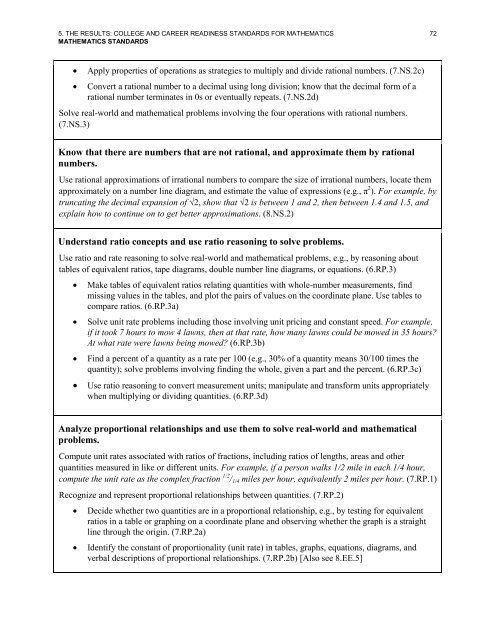CCRStandardsAdultEd
Create successful ePaper yourself
Turn your PDF publications into a flip-book with our unique Google optimized e-Paper software.
5. THE RESULTS: COLLEGE AND CAREER READINESS STANDARDS FOR MATHEMATICS 72<br />
MATHEMATICS STANDARDS<br />
• Apply properties of operations as strategies to multiply and divide rational numbers. (7.NS.2c)<br />
• Convert a rational number to a decimal using long division; know that the decimal form of a<br />
rational number terminates in 0s or eventually repeats. (7.NS.2d)<br />
Solve real-world and mathematical problems involving the four operations with rational numbers.<br />
(7.NS.3)<br />
Know that there are numbers that are not rational, and approximate them by rational<br />
numbers.<br />
Use rational approximations of irrational numbers to compare the size of irrational numbers, locate them<br />
approximately on a number line diagram, and estimate the value of expressions (e.g., π 2 ). For example, by<br />
truncating the decimal expansion of √2, show that √2 is between 1 and 2, then between 1.4 and 1.5, and<br />
explain how to continue on to get better approximations. (8.NS.2)<br />
Understand ratio concepts and use ratio reasoning to solve problems.<br />
Use ratio and rate reasoning to solve real-world and mathematical problems, e.g., by reasoning about<br />
tables of equivalent ratios, tape diagrams, double number line diagrams, or equations. (6.RP.3)<br />
• Make tables of equivalent ratios relating quantities with whole-number measurements, find<br />
missing values in the tables, and plot the pairs of values on the coordinate plane. Use tables to<br />
compare ratios. (6.RP.3a)<br />
• Solve unit rate problems including those involving unit pricing and constant speed. For example,<br />
if it took 7 hours to mow 4 lawns, then at that rate, how many lawns could be mowed in 35 hours?<br />
At what rate were lawns being mowed? (6.RP.3b)<br />
• Find a percent of a quantity as a rate per 100 (e.g., 30% of a quantity means 30/100 times the<br />
quantity); solve problems involving finding the whole, given a part and the percent. (6.RP.3c)<br />
• Use ratio reasoning to convert measurement units; manipulate and transform units appropriately<br />
when multiplying or dividing quantities. (6.RP.3d)<br />
Analyze proportional relationships and use them to solve real-world and mathematical<br />
problems.<br />
Compute unit rates associated with ratios of fractions, including ratios of lengths, areas and other<br />
quantities measured in like or different units. For example, if a person walks 1/2 mile in each 1/4 hour,<br />
compute the unit rate as the complex fraction 1/2 / 1/4 miles per hour, equivalently 2 miles per hour. (7.RP.1)<br />
Recognize and represent proportional relationships between quantities. (7.RP.2)<br />
• Decide whether two quantities are in a proportional relationship, e.g., by testing for equivalent<br />
ratios in a table or graphing on a coordinate plane and observing whether the graph is a straight<br />
line through the origin. (7.RP.2a)<br />
• Identify the constant of proportionality (unit rate) in tables, graphs, equations, diagrams, and<br />
verbal descriptions of proportional relationships. (7.RP.2b) [Also see 8.EE.5]


